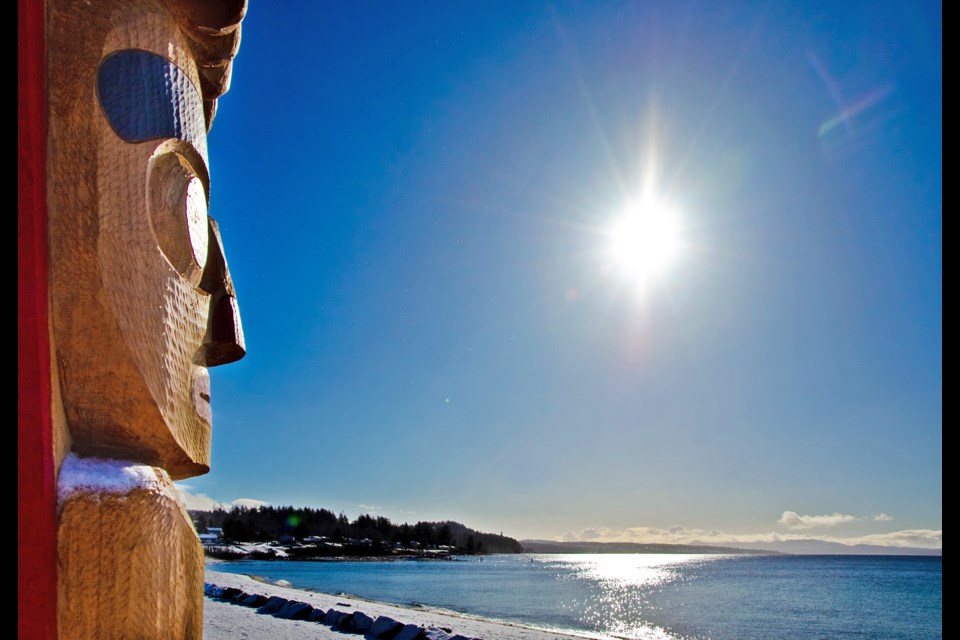Under the direction of master carver Calvin Hunt from Kwakiutl territory (Fort Rupert, Port Hardy, Vancouver Island), Karver Everson (Comox), Randy Timothy, Ivan Rosypskye and Sherman Pallen (Tla’amin territory), two flat-back poles were carved and placed north of the church in Tishosem, facing the beach in Tla’amin territory last September.
“We originally wanted one when we were to host the 2021 Tribal Canoe Journey,” said Tla’amin cultural heritage manager, Drew Blaney. “Our elders pulled us aside and told us they wanted a welcome figure on our beach holding a big paddle to welcome the canoes coming into our territory.”
The annual event, called Tribal Journeys, celebrates the traditional way to travel between Pacific Northwest communities and raises awareness about the cross-border connection between nations.
Unfortunately, because of the ongoing COVID-19 pandemic, the annual Canoe Journey was cancelled that year and the totems put on hold.
Now facing north toward the waters of ʔayajuθəm, Desolation Sound, observers can see a welcome figure on top and below a raven crest of Tla’amin Nation, which is prominent in its creation stories.
“We wanted a raven and watchman figure [on the totem] to watch over the territory,” said Blaney.
COVID-19 was devastating to Tla’amin as the nation lost many community members. Another painful reality came along for the community when Tk'emlúps te Secwe̓pemc announced that possible remains of children were found around the former Kamloops Residential School, in BC’s interior. This was especially painful for Tla’amin elders in the community, as most would have gone to residential schools.
“We decided we wanted to make another pole in recognition of the residential school children plus all the people we lost during the COVID-19 pandemic,” said Blaney. “So the second one is a memorial pole with an eagle at the top and a whale below. Both the whale and eagle are representative of bringing our ancestors home.”
A watchman figure on the bottom can also be seen.
“There are so many residential school survivors in our community and a lot of us are a part of the first generation [after the residential school generation],” said Blaney. “My mom went to residential school, so when these stories came out [about unmarked burial sites] it hit us hard.”
Blaney also wanted to emphasize the artistic style of the poles, called flat-back, a traditional type of carving that would have been seen in Tla’amin territory that stretches over to the Comox region on Vancouver Island.
Historical photos show totems across the North Coast/Salish region, which Tla’amin is a part of, and have a similar flat-back style.
Outside the new and greatly anticipated ƛaχƛaχay ʔaye (Klah Klah Hay Ayeh), or Elders House, a third pole can be seen. Local and lead carvers Ivan Rosypskye and Randy Timothy Sr. created the totem with the Tla’amin creation story in mind.
In the same North Coast/Salish flat-back style, a woman can be seen surrounded by 11 dog children, the first ancestors of the Tla’amin people.
On top of the pole is a raven holding a clam shell with a burning ember in its mouth and a woman with her 11 puppies.
“The 11th puppy is kind of hidden; people have said they can’t see it,” said Blaney. “It’s on the top of the woman’s clam-digging stick.”
Blaney reiterated a speech given by Timothy Sr. outside the Elders House. He said: “It hits us hard because a lot of those children found in the graves, they would have been grandparents now but they didn’t have a chance to make it home.”
This year Tla’amin is having a big celebration on National Indigenous Peoples Day, June 21, in their community, to make up for the past few years.
Another tradition that is back, giving the community a sense of renewal, is the continuation of Tribal Journeys, the 11-day canoe paddle, and this year, Tla’amin is taking all three of the nation’s large sea canoes down to Muckleshoot (present-day Washington State).
“We have a safety boat and a land crew that will go ahead and set up tents, and when we get to the next territory [Sechelt], we ask permission to come ashore and share a meal with them, share protocol and cultural sharing,” said Blaney.
The Muckleshoot Tribe will be hosting the final celebration July 30, 2023, the first one since the pandemic




